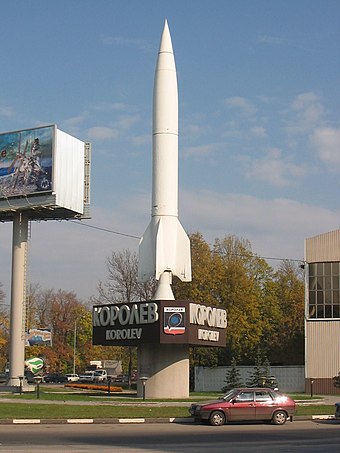
Back آر-2 Arabic R-2 Azerbaijani Р-2 (ракета) Bulgarian R-2 (míssil) Catalan R-2 Czech R-2 (Rakete) German R-2 (misil) Spanish آر-۲ (موشک) Persian R-2 (ohjus) Finnish R-2 French
| R-2 | |
|---|---|
 R-2 missile at Korolev City of Moscow region | |
| Type | Theatre ballistic missile Short-range ballistic missile |
| Place of origin | USSR |
| Service history | |
| In service | 27 November 1951 – 1962 |
| Used by | Soviet Union |
| Production history | |
| Manufacturer | Yuzhmash and OKB-1 |
| Specifications | |
| Mass | 19,632 kg |
| Length | 17.65 m |
| Diameter | 1.65 m |
| Wingspan | 3.60 m |
| Engine | RD-101 |
| Propellant | LOX / Alcohol |
Operational range | 576 km (358 mi) |
| Maximum speed | 2175 m/s |
| Accuracy | 8 km[1] |

The R-2 (NATO reporting name SS-2 Sibling) was a Soviet short-range ballistic missile developed from and having twice the range as the R-1 missile (itself a copy of the German V-2). Developed from 1946-1951, the R-2 entered service in numbers in 1953 and was deployed in mobile units throughout the Soviet Union until 1962. A sounding rocket derivative, the R-2A, tested a prototype of the dog-carrying capsule flown on Sputnik 2 in 1957. The same year, the R-2 was licensed for production in the People's Republic of China, where it entered service as the Dongfeng 1.
- ^ Podvig, Pavel, ed. (2004). Russian Strategic Nuclear Forces. MIT Press. p. 119. ISBN 9780262661812.